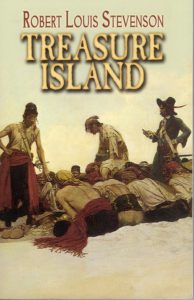Book Review: Treasure Island by Robert Louis Stevenson
In the year of grace 17–, the Admiral Benbow was a quiet seaside inn run by the Hawkins family. Its relative isolation and excellent view of the surrounding waters recommended the place to a disreputable-looking sailor who preferred to be called “captain” and nothing else. The captain wants no visitors, and asks the son of the innkeeper, Jim Hawkins, to keep an eye out for nautical travelers in the vicinity, particularly any one-legged seamen, as that one was particularly dangerous. In the end, it’s a race between Billy Bones’ old crew (no captain he, but only first mate) and his alcoholism to kill him first. However, it’s Jim Hawkins who ends up with the real prize, a map to Treasure Island!
This classic adventure novel was written in 1881 while Robert Louis Stevenson was in Switzerland for his health and originally serialized in Young Folks magazine under the title The Sea-Cook, before being published in the form we know today in 1883. It’s the pirate story that originated or popularized most of the genre bits we think of when we think of pirates, such as the pirate parrot. The book was so influential that when J.M. Barrie wanted Peter Pan‘s villain to seem impressive, he wrote that even Long John Silver was afraid of Captain Hook.
Jim Hawkins’ age is never specifically mentioned, he seems to be in his early teens, old enough to work around the inn and later as a cabin boy, but much less big or strong than a grown man. His father dies early on of natural causes, and the last we see of his mother is just before the voyage to Treasure Island begins. (We do, however, get a great moment of characterization for her as she has no hesitation about raiding the proverbial dead man’s chest for the back rent Billy Bones owes the inn. But not a penny more, even though doing the arithmetic puts her life in even more danger.) This is, after all, very much a boys’ adventure story. Jim’s boyish whims and tendency to wander off on his own prove vital to the survival of the treasure hunters. First, he discovers the mutiny plot, then the existence of Ben Gunn (the one man on the island who can help them) and finally denies the mutineers their ship.
Squire Trelawney is an ass at the beginning of the book, blabbing the treasure hunt all over town after being specifically warned not to. There’s also a couple of lines where he comes off sexist and/or racist, but that may be period-appropriate. The squire owns up to his stupidity when the consequences become clear to him, and starts pulling his weight for the rest of the adventure.
Doctor Livesey is more intelligent, and a man of honor, but has a tendency to be scolding and self-righteous, as well as a heavy smoker. Captain Smollett is a stern master of the good ship Hispaniola, and wise in the ways of the sea, but is overridden by Squire Trelawney on the matter of some of the crew hired, and then badly injured in a battle, so can only give advice from then on.
And on the other side, we have Long John Silver, cunning, ruthless and much-feared pirate quartermaster and sea-cook. But you wouldn’t know it to look at him. His appearance is that of a jolly one-legged innkeeper, which is what he’s doing in Bristol when Jim meets him. Unlike most of Captain Flint’s old crew, Mr. Silver saved his booty and invested wisely. Only the lure of the much greater treasure buried on Treasure Island makes him risk the danger of being caught. And to be perfectly honest, his original plan would have worked if it were not for Jim Hawkins and Ben Gunn being in the wrong place at the right time.
Mr. Silver also has a well-honed sense of self-preservation, switching sides whenever it’s convenient for him. On the other hand, Long John is a faithful and loving husband who trusts his wife implicitly. (And is probably less racist than many other Englishmen.) A well-spoken villain with some good qualities, he’s one of the main ingredients that makes the book work.
The ending is a bit abrupt, with a quick overview of what became of several of the characters–we know Jim survives, and presumably spent some of his money on a good education as he’s a skilled writer…but he still has screaming nightmares about the island and what happened there.
Highly recommended to adventure lovers who have somehow never read this book before. Younger readers may need help with some antiquated vocabulary, and there are quite a few violent deaths so parents should consider that before reading it as a bedtime story.

